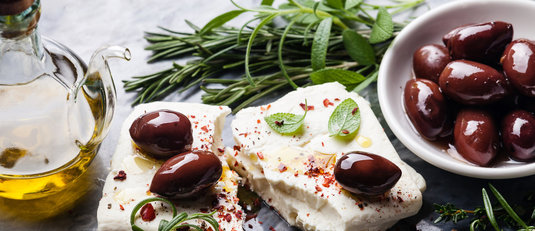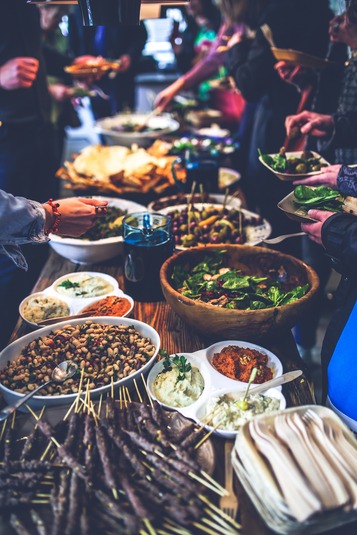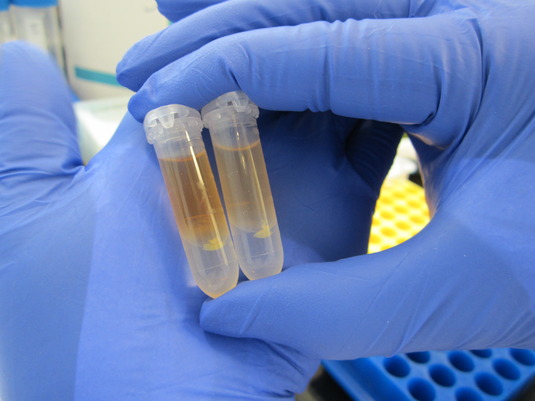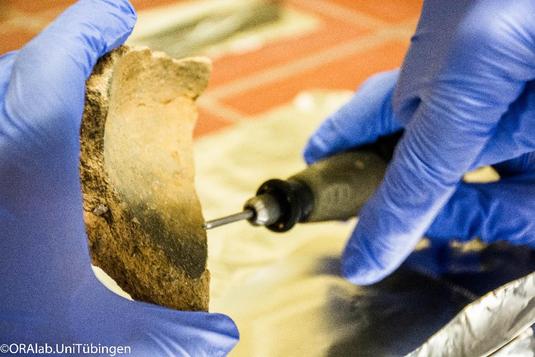FoodTransforms - Transformations of Food in the Eastern Mediterranean Late Bronze Age
ERC Starting Grant 2015 “FoodTransforms: Transformations of Food in the Eastern
Mediterranean Late Bronze Age“


- Project Leader: Philipp W. Stockhammer
- Project Members: please click here
- ERC Starting Grant
Budget: 1,499,125.00 €, financed by the European Research Council -
Project term: 01.07.2016–30.06.2021
Introduction

Food studies provide insight into diet, nutrition and health of ancient cultures and offer information on a variety of aspects including agriculture and farming, as well as environmental issues. Beyond ecology, food analysis addresses socio-political topics, such as economy, mobility, gender, status and social hierarchies. Furthermore, in a medical-magical context, research deals with ritual, symbolic and qualitative meaning of food and consumption. Mediterranean cuisine (prior to the more recent introduction of plants from the New World) has long been perceived as a timeless constant, already linking the different societies around the sea by the 2nd millennium BC. The geographic frame was considered to be essential, whereas intercultural entanglements as transformative factors were neglected. However, it has become clear that the different elements perceived as hallmarks of Mediterranean cuisine (olive oil, wine, wheat bread etc.) were developed in specific regions and then spread through human agency. By integrating archaeological, textual and scientific research, we will shed new light on the transformative power of cultural encounters arising from the intense connectivity between local communities in the Eastern Mediterranean Late Bronze Age and the simultaneous introduction of food of South and East Asian origin (e.g. pepper, nutmeg, cinnamon) as key factors for the genesis of what we nowadays perceive as the Mediterranean diet.
Goa
 ls
lsOur overall hypothesis is that the present uniformity of the Eastern Mediterranean cuisine is the result of the transformative power of long-term intercultural contact and not of the similar landscape and vegetation. We therefore want to investigate the crucial role of early globalisation processes in the 2nd mill. BC for the (trans-)formation of the Eastern Mediterranean cuisine.
We want to reach our overall goal by three specific objectives:
1. To trace regional differences in the Eastern
Mediterranean cuisine in the Late bronze Age.2. To clarify developments of local cuisine in the
different regions during this time.3. To enable the exact translation of so-far not understood
sources and, consequently, gain a better
understanding of textual evidence on food in
Egypt.
ApproachWe intend to achieve this goal by analysing human remains and pottery vessels from selected sites between the Aegean, the Southern Levant and Egypt from the 15th to the 12th cent. BC in order to trace spatial and temporal dynamics. Organic residue analyses of the pottery will shed light on the preparation and consumption of food (e.g. oils, wine, spices). We will include vessels with their contents labelled in the Egyptian Hieratic script on them and then link the results with textual evidence, which enables a new understanding of these sources for the study of food in general.
We combine the results from residue analyses with a cutting-edge approach to the study of human dental calculus, the potential of which has just been recognized for the understanding of human nutrition. This will give unique insight into individual consumption of different oils (olive, sesame etc.), kinds of milk (cow, sheep, goat) and related products (cheese, kefir) and of plants (spices, cereals), which goes far beyond what has been achieved to date. The multidisciplinary approach will allow us to trace processes of homogenisation and diversification as consequences of early globalisation and better understand food circulation in present and future globalisation processes.
Study of Human Dental Calculus (HDC)
Although there are numerous ways to investigate the food and drink consumed in antiquity, perhaps the most powerful evidence is based on material obtained from inside the mouth. One such material is dental calculus (tartar), a calcified microbial biofilm that builds up in layers over the years. HDC is an abundant, nearly ubiquitous, and long-term reservoir of the ancient oral microbiome, preserving not only microbial and host biomolecules but also dietary and environmental debris. Being a closed, protective system, it enhances the preservation of organic residues and provides secure evidence for individual dietary intake. By studying HDC, we achieve novel insights into what individuals of the past usually ate during their lifetime and zoom into individual diets in the past in a so-far unprecedented depth.
The study of HDC aims at gaining the inherent ancient DNA (aDNA) of food and bacteria, but also plant micro-remains, lipids and proteins. We analyse lipids and biomarkers with the help of Thermal Desorptio n and Pyrolysis Gas Chromatography-Mass Spectrometry, and proteins by means of Gas Chromatography-
n and Pyrolysis Gas Chromatography-Mass Spectrometry, and proteins by means of Gas Chromatography-
Tandem Mass Spectrometry. Whereas the lipids and biomarkers can inform us about e.g. the consumption of seafood or bee products by past individuals, our focus on dairy proteins will tell us what kinds of milk and milk products were consumed. We also study phytoliths and starch grains under the polarising microscope which enables us to identify different kinds of plants which were eaten, but also gives insight into the plants that were cooked.
Organic residue analysisBesides our study of human dental calculus we focus on food remains in pottery vessels – especially vessels from the burials of the deceased which we study and vessels from Egypt that have a label on them which informs us about their past content. Organic residue analysis enables us to identify a wide range of animal products (e.g. animal adipose fats, ruminant dairy fats and marine oils), plant oils and waxes, bee products, bitumen, fermented beverages, resins, and tars. The basis for this technique is the fact that liquid components of foodstuffs become absorbed within the walls of porous ceramic vessels. The structure and hydrophobic nature of lipids impart a high preservation potential over archaeological timescales, which is enhanced by their absorption within the ceramic matrix. We extract these residues from the vessels and study them with the help of Gas Chromatography-Mass Spectrometry and if necessary also with Gas Chromatography-Combustion-Isotope Ratio Mass Spectrometry.

Textual Evidence
The vessels from Egypt that we use for organic residue analysis bear Hieratic inscriptions (“labels”, “jar dockets”), which name the content and often the date, quality, origin, producer and proprietor. Of special importance for us are foodstuffs that can be read, but not clearly identified to date. With the help of ORA, we are trying to gain a new understanding of terms for food. These are e.g. bꜣq-oil, srm.t-beer, smj (a kind of curd or butter?), but also the exact mixture of different wines (like sweet wine or šdḥ wine), the source of some fats and possible preparation or conservation processes of meat and fowl. Terms for substances other than foodstuffs, which occur on pot inscriptions, like mrḥ.t oil, sgnn oil and incense are of interest for us as well, as we like to know about the substances used and traded during the Egyptian New Kingdom, which could be used in other context for seasoning or preserving food.
After the successful analyses of the jar contents, the results will be linked with the rich textual (or iconographic) evidence on the respective foodstuffs, in order to get information about their consumption, production and value in the Egyptian culture. Furthermore, by including all available sources about foreign contacts and possible trading mechanisms, we want to explore the ways in which non-indigenous or exotic substances were introduced during the Late Bronze Age.
FoodTransform's publications
Bechar et al. 2021: S. Bechar/A. Ben-Tor/I. Wachtel/D. Ben-Tor/E. Boaretto/P. W. Stockhammer, The Destruction of Late Bronze Age Hazor. Ägypten und Levante 31, 2021, 45-73.
Buckley et al. 2021: S. Buckley/R. C. Power/M. Andreadaki-Vlazaki/M. Akar/J. Becher/M. Belser/S. Cafisso/S. Eisenmann/J. Fletcher/M. Francken/B. Hallager/K. Harvati/T. Ingman/E. Kataki/J. Maran/M. A. S. Martin/P. J. P. McGeorge/I. Milevski/A. Papadimitriou/E. Protopapadaki/D. C. Salazar-García/T. Schmidt-Schultz/V. J. Schuenemann/R. Shafiq/I. Stuijts/D. Yegorov/K. A. Yener/M. Schultz/C. Spiteri/P. W. Stockhammer, Archaeometric evidence for earliest exploitation of lignite from the bronze age Eastern Mediterranean. Scientific Reports 11:24185, 2021, 1-11. https://doi.org/10.1038/s41598-021-03544-w
Eisenmann et al. 2018: S. Eisenmann/E. Bánffy/P. van Dommelen/K. P. Hofmann/J. Maran/I. Lazaridis/A. Mittnik/M. McCormick/J. Krause/D. Reich/P. W. Stockhammer, Reconciling material cultures in archaeology with genetic data: The nomenclature of clusters emerging from archaeogenomic analysis. Scientific Reports 8/1, 13003, 2018. https://doi.org/10.1038/s41598-018-31123-z
Fellows Yates et al. 2021a: J. A. Fellows Yates/A. Andrades Valtueña/Å. J. Vågene/B. Cribdon/I. M. Velsko/M. Borry/M. J. Bravo-López/A. Fernandez-Guerra/E. J. Green/S. L. Ramachandran/P. D. Heintzman/M. A. Spyrou/A. Hübner/A. S. Gancz/J. Hider/A. F. Allshouse/V. Zaro/C. Warinner, Community-curated and standardised metadata of published ancient metagenomic samples with AncientMetagenomeDir. Scientific Data 8/1, 31, 2021. https://doi.org/10.1038/s41597-021-00816-y
Fellows Yates et al. 2021b: J. A. Fellows Yates/T. C. Lamnidis/M. Borry/A. Andrades Valtueña/Z. Fagernäs/S. Clayton/M. U. Garcia/J. Neukamm/A. Peltzer, Reproducible, portable, and efficient ancient genome reconstruction with nf-core/eager. PeerJ 9, 2021: e10947. https://doi.org/10.7717/peerj.10947
Fries-Knoblach/Stockhammer 2022: J. Fries-Knoblach/P. W. Stockhammer, New bioarchaeological approaches to the study of plant food practices in the Eastern Mediterranean during the 2nd millennium BCE. In: S. M. Valamoti/A. Dimoula/M. Ntinou (eds), Cooking with Plants in Ancient Europe and Beyond: Interdisciplinary approaches to the Archaeology of Plant Foods (Leiden: Sidestone 2022) 113-142. https://www.sidestone.com/books/cooking-with-plants-in-ancient-europe-and-beyond
Hendy et al. 2018: J. Hendy/F. Welker/B. Demarchi/C. Speller/C. Warinner/M. J. Collins, A guide to ancient protein studies. Nature Ecology and Evolution 2/5, 2018, 791-799. https://doi.org/10.17863/cam.90832
Ingman et al. 2021: T. Ingman/S. Eisenmann/E. Skourtanioti/M. Akar/J. Ilgner/G. A. Gnecchi Ruscone/P. le Roux/R. Shafiq/G. U. Neumann/M. Keller/C. Freund/S. Marzo/M. Lucas/J. Krause/P. Roberts/K. A. Yener/P. W. Stockhammer, Human mobility at Tell Atchana (Alalakh), Hatay, Turkey during the 2nd millennium BC: Integration of isotopic and genomic evidence. PLoS ONE 16(6), 2021: e0241883. https://doi.org/10.1371/journal.pone.0241883
Linares et al. 2019: V. Linares/M. J. Adams/M. S. Cradic/I. Finkelstein/O. Lipschits/M. A. S. Martin/R. Neumann/P. W. Stockhammer/Y. Gadot, First evidence for vanillin in the old world: Its use as mortuary offering in Middle Bronze Canaan. Journal of Archaeological Science Reports 25, 2019, 77-84. https://doi.org/10.1016/j.jasrep.2019.03.034
Mann et al. 2023: A. E. Mann/J. A. Fellows Yates/Z. Fagernäs/R. M. Austin/E. A. Nelson/C. A. Hofman, Do I have something in my teeth? The trouble with genetic analyses of diet from archaeological dental calculus. Quaternary International 653-654, April 2023, 33-46. https://doi.org/10.1016/j.quaint.2020.11.019
Rageot/Stockhammer 2023: M. Rageot/P. W. Stockhammer, Deciphering the chemistry of embalming. In: K. Jensen (ed.), Ancient Egypt. Obsessed with life. Exhibition catalogue Moesgaard Museum (Århus 2023) 57-67.
Rageot et al. 2023: M. Rageot/R. B. Hussein/S. Beck/V. Altmann-Wendling/M. I. M. Ibrahim/M. M. Bahgat/A. M. Yousef/K. Mittelstaedt/J.-J. Filippi/St. Buckley/C. Spiteri/P. W. Stockhammer, Biomolecular analyses enable new insights into ancient Egyptian embalming. Nature 2/2023, 1-19. https://doi.org/10.1038/s41586-022-05663-4
Scott et al. 2020: A. Scott/R. C. Power/V. Altmann-Wendling/M. Artzy/M. A. S. Martin/S. Eisenmann/R. Hagan/D. C. Salazar-Garcia/Y. Salmon/D. Yegorov/I. Milevski/I. Finkelstein/P. W. Stockhammer/C. Warinner, Exotic foods reveal contact between South Asia and the Near East during the second millennium BCE. Proceedings of the National Academy of Sciences Dec. 2020, 202014956, 1-10. https://doi.org/10.1073/pnas.2014956117
Scott et al. 2022: A. Scott/S. Reinhold/T. Hermes/A. A. Kalmykov/A. Belinskiy/A. Buzhilova/N. Berezina/A. R. Kantorovich/V. E. Maslov/F. Guliyev/B. Lyonnet/P. Gasimov/B. Jalilov/J. Eminli/E. Iskandarov/E. Hammer/S. E. Nugent/R. Hagan/K. Majander/P. Onkamo/K. Nordqvist/N. Shishlina/E. Kaverzneva/A. I. Korolev/A. A. Khokhlov/R. V. Smolyaninov/S. V. Sharapova/R. Krause/M. Karapetian/E. Stolarczyk/J. Krause/S. Hansen/W. Haak/C. Warinner, Emergence and intensification of dairying in the Caucasus and Eurasian steppes. Nature Ecology and Evolution 6/6, 2022, 813-822. https://doi.org/10.1038/s41559-022-01701-6
Stockhammer 2017: P. W. Stockhammer, Afterword: The pot and the archaeologist – changing each other in an (un-)happy marriage? In: C. Heitz/R. Stapfer (eds), Mobility and pottery production. Archaeological & anthropological perspectives (Leiden: Sidestone 2017). https://doi.org/10.11588/propylaeumdok.00003858
Stockhammer 2022: P. W. Stockhammer, Aegean-type Pottery from Megiddo, Areas K and H. In: I. Finkelstein/M. A. S. Martin (eds), Megiddo VI: The 2010–2014 Seasons. Monograph Series of the Institute of Archaeology of Tel Aviv University 41 (Tel Aviv, Eisenbrauns: University Park 2022) 763-779.
Stockhammer et al. 2018: P. W. Stockhammer/B. Athanassov/M. Ivanova, Introduction: Social dimensions of food. In: M. Ivanova/B. Athanassov/V. Petrova/D. Takorova/Philipp W. Stockhammer (eds.), Social dimensions of food in the prehistoric Balkans (Oxford: Oxbow 2018) VII-XVII. https://doi.org/10.11588/propylaeumdok.00004342
Wilkin et al. 2020: S. Wilkin/A. Ventresca Miller/W. T. T. Taylor/B. K. Miller/R. Hagan/M. Bleasdale/A. Scott/S. Gankhuyg/A. Ramsøe/S. Uliziibayar/C. Trachsel/P. Nanni/J. Grossmann/L. Orlando/M. Horton/P. W. Stockhammer/E. Myagmar/N. Boivin/C. Warinner/J. Hendy, Dairy pastoralism sustained eastern Eurasian steppe populations for 5,000 years. Nature Ecology and Evolution 4, 2020, 346-355. https://doi.org/10.1038/s41559-020-1120-y

